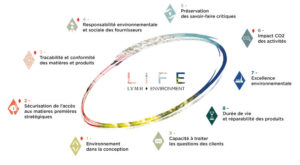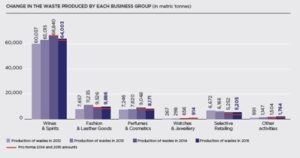Carbon-Cutting Is Now En Vogue

LVMH is pioneering the sustainability efforts against climate change for the Luxury Goods industry, one handbag at a time.
Gucci. Chanel. Louis Vuitton. What is this year’s hottest luxury trend? Exotic furs? Soft neutrals? Head-to-toe cashmere? No. This year, according to the major luxury retail houses, the only thing that is in fashion is energy conservation. LVMH, the French luxury conglomerate that owns icons such as Louis Vuitton, Moet Hennessy, Guerlain and Bulgari, is pioneering the message that environmental sustainability is now a necessity for long-term survival and profitability in luxury retail.
Climate Change and Luxury Retail: Defining the Problem
The fundamental value proposition of luxury retail is to deliver beautiful, creative products crafted from rare, high-quality materials. However, this dependence on high-quality raw materials exposes the industry to the detrimental effects of climate change because luxury good raw materials come from natural and agricultural systems that are limited geographically and can be particularly vulnerable to climate variations. Existing climate change forecasts threaten to jeopardize raw materials sourcing in terms of quality and availability, and luxury goods depend on these materials more than any other industry.
Cashmere, leather, vicuña, silk and cotton are examples of materials that are already experiencing compromises due to climate change. Some have become more likely to be insect infested, others have adopted coarser fibers, and increased heat and drought have decreased the yield and geographical harvesting ranges of all [1]. At the business level, this will lead to more price spikes for the consumer and decreased profitability for luxury retailers.
Moreover, studies have shown that most luxury raw materials, as a testament to their rarity, tend to be sourced from small-scale farmers in rural and coastal communities, which have been and will be most impacted by climate change. They are particularly susceptible to climate extremes, such as droughts, heatwaves, temperature variability and hurricanes caused by warming waters and long-term shifts [2].
Therefore, in order to ensure long-term survival and profitability, luxury brands must strategically plan for long-term sourcing and introduce sustainability practices into their growth strategies to mitigate the inevitable effects of climate change on the fundamental value proposition of their businesses.
LVMH and Sustainability
On average, the supply chain accounts for 50% of a typical retail corporation’s carbon emissions [3]. Therefore, LVMH has focused its sustainability program on managing supply chain disruptions. The company is building resiliency to climate change by (1) looking to avoid unmanageable climate change (reducing emissions across its value chain), and (2) managing unavoidable climate change (investing in green infrastructure, building climate-proof facilities, focusing on climate resilient production of raw materials, etc.) [4, 5] These efforts have manifested in three primary sustainability initiatives, highlighted below, and have really sprung the company forward in terms of environmental efficiency (Figure 2).
1) LIFE
Most recently, LVMH implemented a comprehensive sustainability initiative, called the LIFE program (Figure 1), to synthesize the sustainability efforts of all of its businesses. LIFE aims to address five primary concerns [6]:
- Save energy resources and combat climate change
- Protect and save water resources
- Protect ecosystems and natural resources
- Waste recovery
- Minimize impact of production and transformation of raw materials
Figure 1:

2) Carbon Reduction Program
LVMH has also supplemented the LIFE program by introducing an internal carbon price, which requires its businesses to invest €15 in financing innovative projects every time they emit one metric ton of greenhouse gas in order to reduce emissions [7].
By 2020, LVMH is committed to reducing energy consumption by 20% and increasing consumption of renewable energy by 50%, reflecting a 60% decrease in greenhouse gas emissions [8].
3) Sustainability at Retail Stores
LVMH retail stores are responsible for 80% of the company’s total greenhouse gas emissions [9]. LVMH is committed to reducing these levels by:
- Developing eco-lighting through LED technology, which has already been installed in over 60% of Thomas Pink stores and 175 Sephora boutiques [10]; and
- Improving energy management with real-time consumption-monitoring technology such as “smart thermostats.” [11]
Figure 2:

Is there more to do?
While LVMH has led the supply chain sustainability phenomenon for luxury retail, its peers have innovated in other ways that the company could aim to adopt:
1) Introduce eco-friendly fashion: Compared to its peers, LVMH has yet to enter the green movement of fashion, which features high-end ultra-luxe pieces fashioned from sustainable materials by environmentally-friendly designers that don’t comprise on desirability [12].
Figure 3:
Source: “Manolo Blahnik, M. Patmos Make Eco-Friendly Shoes From Waste Tilapia Skins, Cork,” http://www.ecouterre.com/manolo-blahnik-m-patmos-make-eco-friendly-shoes-from-waste-tilapia-skins-cork/, accessed November 2016.
2) Waste reduction: While LVMH has focused on waste recovery, the only business segment that has experienced notable improvement in this area has been wines & spirits (Figure 4). As demonstrated by its competitor, Kering Group, other segments such as leather goods could benefit immensely from improved waste reduction and provide tremendous long-term cost savings for the company [13].
Figure 4:

3) Increase transparency: Tools such as the “Energy P&L” implemented by Kering Group encourage public awareness of climate change and push other luxury retailers to adopt similar policies [14].
Luxury brands have a unique power to influence by setting trends and promoting aspirational change for social good. LVMH should continue to do what it has always done best – inspire people to desire – in support of a climate-smart world.
Word Count: 793 (excluding citations)
Sources
- Crowley, H; Driscoll Goulay, C; Niemtzow, E.; Norton, T.; Prattico, E; and Woods, B. 2015. “Climate Change: Implications and Strategies for the Luxury Fashion Sector.” BSR Working Paper in collaboration with Kering. BSR, San Francisco.
- Hewston, R.; Allan, J.; Dobson, O. and Nichols, W. 2015. “Assessing climate change risks in commodity supply chains”. Verisk Maplecroft.
- T. Kearney. 2011. “Supply Chain Report 2011: Migrating to a low carbon economy through leadership and collaboration”. Carbon Disclosure Project. www.cdp.net/CDPResults/CDP-2011-Supply-Chain-Report.pdf, accessed November 2016.
- Crowley, H; Driscoll Goulay, C; Niemtzow, E.; Norton, T.; Prattico, E; and Woods, B. 2015. “Climate Change: Implications and Strategies for the Luxury Fashion Sector.”
- Positive Luxury; 2016. “2016 Predictions for the Luxury Industry: Sustainability and Innovation.”
- LVMH 2015 Environmental Report. https://r.lvmh-static.com/uploads/2016/04/rapport-environnement-2015-va.pdf, accessed November 2016.
- Ibid.
- Ibid.
- Ibid.
- Ibid.
- Ibid.
- McMillan, Aya. “7 Sustainable Luxury Brands Making Eco-friendly Fashion.” http://www.ellecanada.com/fashion/trends/article/7-sustainable-luxury-brands-making-eco-friendly-fashion, accessed November 2016.
- Cardamenis, Forrest. “Climate Change Could Jeopardize Access to High-Quality Materials.” https://www.luxurydaily.com/climate-change-could-jeopardize-access-to-high-quality-materials-report/, accessed November 2016.
- Kering, 2014. Environmental P&L. http://www.kering.com/sites/default/files/document/kering_group_2014_environmentalpl.pdf, accessed November 2016.





This post was impactful for me as a follower of luxury brands, because when we think of luxury brands, it doesn’t typically conjure visions of sustainability. I was so impressed to learn that LVMH – arguably the holistic leader in many luxury industries – has climate change top of mind. It seems LVMH has invested in efforts that not only align with their firm-wide values but also can be integrated well into their existing day-to-day operations. Baking these new standards and way of operating into their existing infrastructure makes it much more digestible to adhere to. The point here I really wanted to explore was around introducing wearable pieces into future lines that appear to be made of sustainable materials. While I completely agree with Catherine that this is an obvious next step (seeing as LVMH competitors have already moved in this direction), I do see a potential tension between customer expectations from LVMH lines and what LVMH actually delivers. Luxury buyers are historically choosy and particular – do we think that customers would actually be put off by products that look like they are made of sustainable materials? Or do we see enough evidence of luxury buyer consumer behavior indicating that the look of sustainable luxury products is not a deterrent to purchasing? I think this requires significantly more customer research and time to determine if other brands are experiencing higher sales with the release of these sustainable-looking pieces.
It was eye-opening to learn that “the supply chain accounts for 50% of a typical retail corporation’s carbon emissions” – is this number the same for luxury AND commodity fashion items? For example, what additional learnings can LVMH apply to their supply chain practices from companies like H&M?
To @pperonto’s point above – i.e. the tension between consumer expectations and green fashion from LVMH – I am curious if LVMH can change the standard by using its incredible clout as a well-known luxury brand. Specifically, by tapping into a historically wealthier and more sustainably-minded younger population (wealthy, urban millennials, defined as ages 18-34) and eco-minded celebrities, LVMH has the ability to move the conversation on climate change in whichever direction they want it to. As a brand that clearly has a social conscience, In my mind, LVMH has the responsibility, and means, to set the tone and educate their consumers, and in turn influence other luxury houses.
Thanks for spotlighting the luxury retail space with sustainability Catherine! I was pleasantly surprised to see all of LVMH’s initiatives as it is stepping up to combat its impact on the environment. As much as it is doing for the climate and environment, I think it should also look to its impact on wildlife and animals. I personally admire Kering’s Stella McCartney brand as the pioneer in using non-animal materials to manufacture its products and am excited to see her brand doing well in the luxury market. Her bags still command the premium price point and is revered for its design. Top celebrity influencers are regularly seen with her iconic chain link Fallabella bag and helps keep her brand in trend. To Phoebe’s and Anita’s point, the tension between non-animal materials and ‘high quality’ exists and can make consumers question its ‘luxury’ appeal; but, with a brand like Stella McCartney continuing to push this message into the market, I look forward to others, especially in the LVMH wheelhouse, do the same.
Thank you Catherine for this great post on LVMH’s efforts towards sustainability. I found it interesting that having worked for Sephora (a beauty company owned by LVMH, and LVMH’s most profitable arm) for 4 years, I never once heard about a sustainability initiative! It’s possible that these initiatives have not yet made their way to Sephora, but I do find it a bit odd and it serves as an indicator that sustainability is not truly part of the day to day operations of the company, nor top of mind for employees. I believe that in order for sustainability initiatives to work, the entire company needs to be on board and live them each day- each employee should know what he or she needs to do to help towards that effort. At the very least I would think that simple in-office/HQ initiatives such as getting rid of plastic water bottles for meetings would be a simple measure with a significant impact. Unfortunately, that was not my experience at Sephora, where an unbelievable number of plastic water bottles were used and wasted (vs reusable water containers) for every single meeting we had with clients at our offices.
Additionally, having lived nearby to a Sephora store in San Francisco, I noticed that the lights are literally always on in the store (even overnight! I actually inquired about it once and was told that it was a security measure because the store had been broken into a few times. The lights were on to deter thieves! This seemed like a huge waste of energy and while its possible this was an isolated incident, I do believe that LVMH and Sephora can and should be doing so much more towards sustainability. One example would be to leverage the LVMH network and optimize trucks – trucks could be shared amongst the various LVMH brands when making deliveries to locations such as NYC or San Francisco (all large metro areas) where there are multiple LVMH brand stores in the same area.
Finally, as a bit of an aside, and I do not have proof or a true source, but having spoken with someone who worked for Louis Vuitton specifically, the company ultimately ends up burning unsold merchandise so it does not get into “the wrong” hands. Unsold merchandise is first put up in discount for employees but whatever remains is burned. The reason is to keep the brand “luxury” and brand equity, they don’t want any of their products being sold on discount/sale or on e-bay or other discount sites. If this secretive burning practice is true, that cannot be good for the environment!
This is an incredibly interesting post and approach taken by LVMH! I had never heard of a company setting an internal carbon price and creating their own financial impetus to change. Usually it is a government or authority who sets these rules that companies must abide by. I am surprised that they are taking such an aggressive stance toward sustainability!
I’ll be curious to see how they fare with it in the long term since it is still relatively new and early to judge. As they lower their carbon footprint, I wonder if they will continue to invest in other sustainability practices as much.
I also wonder to Yarden’s point, why haven’t they made this company-wide initiative more known?
As many of my peers have noted, prior to reading your post, I would have never associated sustainability with the luxury retail space! I was very surprised to hear about the variety of initiatives that LVMH has put in place to combat climate change – both from an economic and an ecological standpoint. One thing that troubles me about their argument however, is that unlike most other retail companies, LVMH is in a position to pass on many of the potential supply chain costs of climate change onto their end consumer. What’s to stop LVMH from increasing their prices to cover the uptake in cost of raw materials? Given this is the luxury segment of the retail industry, the high cost and exclusively of the item is almost part of the appeal. How can LVMH be held accountable for these potential supply chain impacts instead of passing along these consequences to the end consumer? My main concern is that LVMH is using this sustainability push as a marketing ploy instead of trying to make the industry more accountable for how they procure, produce, and sell their products. Overall, a very interesting industry to take a look at through the lens of sustainability and climate change!
Great post! I think it is interesting to see how different the eco initiatives are in luxury brands vs. high street. It seems to me that, while mass market brands use sustainability as a PR mechanism, luxury brands do it for economic reasons. LED lights give electricity savings in a long run and future lack of high quality materials is a genuine threat to the business model of LVMH and the likes. However, I do not think they will move towards eco conscious fashion line unless for PR purposes. Another interesting luxury brand is Stella McCartney. She was one of the first (if not the first) luxury brand that made it a company strategy to be eco friendly by not selling anything made out of real leather. I personally find it astonishing how popular her luxury synthetic leather handbags are given their price point is as high as other luxury leather bags.
Super interesting post Catherine! I was quite surprised that LVMH’s retail stores contribute 80% of their greenhouse gas emissions. I would have thought that manufacturing of products would be a higher percentage of emissions. It was also interesting to learn that LVMH is focusing on reducing the emissions of their retail stores through a focus on LED lighting. While I agree LED lighting is a great step in reducing energy usage, I also think that LVMH could leverage innovative store design to bring in more natural lighting. LVMH is known for partnering with high end design firms to create iconic retail stores for its brands in key markets. By incorporating sustainable LEED design into these partnerships, LVMH could be truly innovative in the retail landscape.